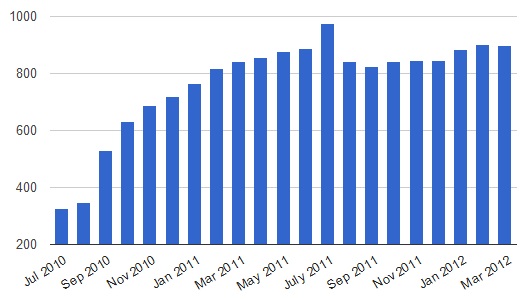[CORRECTION: I removed a line about bottlenecks that specifically mentioned the InWorldz asset server. See discussion in the comments for the full details.]
InWorldz is celebrating it’s third anniversary in Las Vegas this weekend (livestream here, schedule here).
I’m listening to the keynote presentation right now by grid founder Beth Reischl — also known as Elenia Llewellyn in-world. So far, it seems that the grid is focusing on community events and incremental technology improvements.
But I’m not seeing some core issues being discussed. Of course, that’s easy for me to say, watching from the sidelines — but then again, it’s the fact that I’m on the sidelines that makes me think about the bigger picture.
“David [co-founder David Daeschler, also known as Tranquillity Dexler in-world] and I work 17-18 hour days,” Reischl said. “Back in the early days, we’d be up to 3 or 4 o’clock in the morning.”
The InWorldz business model requires a great deal of hands-on management of both technology and of the community, and doesn’t exactly give them a lot of time to step back and reflect.
So here’s some unsolicited advice, for all it’s worth.
I believe that InWorldz is at a turning point now, that the current business model has problems, and that the company has a great opportunity to make a big impact — if it’s willing to take a big risk.
The current model
Today, InWorldz makes money by selling virtual land and virtual currency on its closed, commercial grids. Movement is restricted, both of avatars and of content.
Basically, InWorldz is a smaller, less expensive version of Second Life with not-as-good technology.
There are three major reasons people choose to join InWorldz:
- Their friends are there, or the groups they want to belong to are there
- They think that its expanding, and is the future, and they want to be in a growing world, not a shrinking one
- They don’t want to be on Second Life, and want the next best thing
So fast expansion is no longer a draw for people looking for a virtual world. There is expansion in OpenSim, but it’s in smaller, private and niche grids, interconnected by hypergrid teleport — today, there are more than 70 grids on the hypergrid and more than 4,000 hypergrid travelers using The Hypergates network alone.
And the first reason — to go where friends are — this is where size matters. Size matters quite a bit. Second Life, with its hundred thousand — plus or minus a few tens of thousands — unique monthly users far overshadows InWorldz’ 5,700 active users (at last count).
In addition, niche communities moving as groups out of Second Life in order to be able to get better prices and more control are increasingly setting up their own grids instead of joining existing grids like InWorldz. For example, the owners of Gay Nations and the BDSM-themed Littlefield Grid are able to make their own backups of their entire grids, manage their own users, and switch hosting providers at will if another offers better terms or better service — all while being able to write their own terms of service, instead of having to comply with those of another grid.
Can people belong to more than one grid? Sure. I have an avatar on my company grid, on Second Life, on OSGrid, on my little New World Studio grid at home, and on all the major closed commercial grids, just in case I have to go in and interview someone. But I only actively maintain the avatar on my company grid. Buying clothes, making friends, joining groups — it all takes a lot of time and effort and a bit of money, too. I don’t want to have to find and buy the same outfit 10 times, or even two times. I’ll just get it once, for the avatar I spend the most time with. Â I’ll only get enough stuff for my other avatars not to look like Ruth.
If you do decide to have two active avatars, then you’ve got two different sets of friends who can’t talk to each other. You’re in two sets of groups. You’re invited to two different sets of events. Eventually, you naturally start gravitating to one side or the other. And if Second Life is your other avatar, it’s always going to have an advantage there — more store openings, more fashion shows, more people, more groups, more events, more stuff to do — unless you’ve got a very compelling reason to be in OpenSim.
Meanwhile, if you want land to build on, InWorldz is looking like a poorer and poorer choice every day. You can’t bring in or save OAR files. Land’s cheaper than Second Life — but more expensive than anywhere else, and with more constraints. So you’ve got the creative types moving to Craft, FrancoGrid, OSGrid, and, now, Kitely, where land is super cheap — or free. And, on all the grids except Kitely, you can hypergrid teleport to all the other grid. And Kitely is adding hypergrid teleports right after they get the megaregions enabled.
Meanwhile, InWorldz can’t take advantage of any of the recent developments in OpenSim — mesh, media-on-a-prim, NPCs, megaregions, super stability, hypergrid friends, hypergrid landmarks, hypergrid instant messages, filtered OAR exports (and, soon, filtered hypergrid exports as well). They’re still on 0.6.5 and everyone else is on 0.7.3 and they can’t upgrade because they made a lot of fixes early on that were needed — but they didn’t contribute those fixes back to the open source community. So the open source guys went on, on their own, refactored, fixed everything — but in a different way than InWorldz did. And now InWorldz is stuck out on a branch all by itself. It has to pay for its own development — and there’s no way a single company can keep up with everything being done by volunteers in a giant open source community.
Now, you can try to convince your users that they don’t need mesh, media-on-a-prim, hypergrid, megaregions, backups, Linda Kellie’s magnificent OARs. And maybe a lot of your users don’t. But some will want some of those things, and, increasingly, there will be more and more things that some people want, that they can’t get on InWorldz, and they’ll quietly peel away. They’ll go to Second Life or OSGrid or Kitely or a New World Studio on their own computer, and spend less and less time and money in InWorldz.
Three years ago, when InWorldz first launched, they were ahead of mainline OpenSim — more stable, with features that nobody else had. Their technology was a big selling point.
That is no longer the case. InWorldz scored about the same as the average OpenSim grid in technology in both our 2010 grid survey and the 2011 grid survey — even though most of the other grids in the survey just ran standard OpenSim and did little or no technology work at all.
Where InWorldz is strongest is in their community — so, at this point, all the time and money they’re spending on technology is being wasted, since they could be spending it on community building and marketing, instead.
One vision for the future
Here is my proposal, for InWorldz future development, which will allow the company to build on its core strengths.
Step one: Ditch the proprietary technology. By continuing to invest in it, they’re only digging themselves in deeper. It served its purpose — it’s time to go. And, in the future, donate improvements back to the open source community to keep this same situation from repeating.
Step two: Enable OAR filtering and hypergrid filtering, and allow avatars — and full-perm content — to travel to other grids. Give creators sufficient warning, so that they can reset their permissions if they don’t want their content to leave the grid. Kitely will be rolling this out later on this year, and donating the hypergrid filtering code — or InWorldz can do this work. OAR filtering is already available in the latest official release of Opensim.
Step three: Use InWorldz’ strength in community building to become the central hub of the hypergrid. Expand events, fashion shows, markets, groups to the entire metaverse. Instead of spending money on proprietary physics engines and viewers, spend money on promoting these events across the hypergrid.
Today, InWorldz is the single busiest grid running OpenSim, not counting some of the large private educational grids. They have a reliable currency, and a great brand name. They now have the opportunity to expand on this, and position themselves in the future metaverse.
Or they could go on doing what they’re doing now, rolling out incremental technology improvements and cosmetic viewer improvements. Meanwhile, other grids pull ahead in features, and the hypergrid community grows and evolves until InWorldz becomes marginalized and irrelevant.
- OSgrid back online after extended maintenance - April 16, 2025
- Analysts predict drop in headset sales this year - March 25, 2025
- OSgrid enters immediate long-term maintenance - March 5, 2025


